Development of 2.45 GHz Semiconductor Microwave System for Combustion Ignition Enhancement and Failure Analysis
Abstract
:1. Introduction
2. Experimental System
2.1. Laser Ignition and Spark Ignition System
2.2. Semiconductor Microwave Generator
2.3. Antenna Characteristics
2.4. MDI Detailed Design and Erosion
3. Results
3.1. MW on Spark Plug
3.2. Single vs. Multipoint MDI
3.3. Endurance Test of MDI
3.4. FPI Combustion Promotion Effect and Component Destruction
3.5. Failure Analysis
4. Conclusions
Funding
Institutional Review Board Statement
Informed Consent Statement
Data Availability Statement
Conflicts of Interest
References
- Bradley, D.; Sheppard, C.G.W.; Suardjaja, I.M.; Woolley, R. Fundamentals of high-energy spark ignition with lasers. Combust. Flame 2004, 138, 55–77. [Google Scholar] [CrossRef]
- Sahoo, B.B.; Sahoo, N.; Saha, U.K. Effect of engine parameters and type of gaseous fuel on the performance of dual-fuel gas diesel engines—A critical review. Renew. Sustain. Energy Rev. 2009, 13, 1151–1184. [Google Scholar] [CrossRef]
- Malenshek, M.; Olsen, D.B. Methane number testing of alternative gaseous fuels. Fuel 2009, 88, 650–656. [Google Scholar] [CrossRef]
- Nichols, R.J. 1993 Soichiro Honda Lecture: The Challenges of Change in the Auto Industry: Why Alternative Fuels? J. Eng. Gas Turbines Power 1994, 116, 727–732. [Google Scholar] [CrossRef]
- Seko, T.; Kuroda, E.; Hamano, Y. Methanol lean burn in an auto-ignition DI engine. SAE Trans. 1998, 107, 721–730. [Google Scholar]
- Karim, G.A. Hydrogen as a spark ignition engine fuel. Int. J. Hydrogen Energy 2003, 28, 569–577. [Google Scholar] [CrossRef] [Green Version]
- Kobayashi, H.; Hayakawa, A.; Somarathne, K.K.A.; Okafor, E.C. Science and technology of ammonia combustion. Proc. Combust. Inst. 2019, 37, 109–133. [Google Scholar] [CrossRef]
- Nishiyama, A.; Le, M.K.; Furui, T.; Ikeda, Y. The relationship between in-cylinder flow-field near spark plug areas, the spark behavior, and the combustion performance inside an optical SI engine. Appl. Sci. 2019, 9, 1545. [Google Scholar] [CrossRef] [Green Version]
- Mariani, A.; Foucher, F. Radio frequency spark plug: An ignition system for modern internal combustion engines. Appl. Energy 2014, 122, 151–161. [Google Scholar] [CrossRef]
- Morsy, M.H. Review and recent developments of laser ignition for internal combustion engines applications. Renew. Sustain. Energy Rev. 2012, 16, 4849–4875. [Google Scholar] [CrossRef]
- Beduneau, J.L.; Ikeda, Y. Application of laser ignition on laminar flame front investigation. Exp. Fluids 2004, 36, 108–113. [Google Scholar] [CrossRef]
- Beduneau, J.L.; Kim, B.; Zimmer, L.; Ikeda, Y. Measurements of minimum ignition energy in premixed laminar methane/air flow by using laser induced spark. Combust. Flame 2003, 132, 653–665. [Google Scholar] [CrossRef]
- Kawahara, N.; Beduneau, J.L.; Nakayama, T.; Tomita, E.; Ikeda, Y. Spatially, temporally, and spectrally resolved measurement of laser-induced plasma in air. Appl. Phys. B 2007, 86, 605–614. [Google Scholar] [CrossRef]
- Beduneau, J.L.; Kawahara, N.; Nakayama, T.; Tomita, E.; Ikeda, Y. Laser-induced radical generation and evolution to a self-sustaining flame. Combust. Flame 2009, 156, 642–656. [Google Scholar] [CrossRef]
- Ikeda, Y.; Nishiyama, A.; Kaneko, M. Microwave enhanced ignition process for fuel mixture at elevated pressure of 1MPa. In Proceedings of the 47th AIAA Aerospace Sciences Meeting Including the New Horizons Forum and Aerospace Exposition, Orlando, FL, USA, 5–8 January 2009. [Google Scholar]
- Cheng, X.; Zhang, X.; Wang, Z.; Wu, H.; Wang, Z.; Chen, J.Y. Effect of Microwave Pulses on the Morphology and Development of Spark-Ignited Flame Kernel. Energies 2021, 14, 6205. [Google Scholar] [CrossRef]
- Hwang, J.; Kim, W.; Bae, C. Influence of Plasma-Assisted Ignition on Flame Propagation and Performance in a Spark-Ignition Engine. Appl. Energy Combust. Sci. 2021, 6, 100029. [Google Scholar] [CrossRef]
- Kumar, P.; Yamaki, Y.; Lee, J.; Nakaya, S.; Tsue, M. Effects of Microwave Radiation on Laser Induced Plasma Ignition of N-Butane/Air Mixture under Atmospheric Conditions. Proc. Combust. Inst. 2021, 38, 6593–6603. [Google Scholar] [CrossRef]
- Liu, S.; Zhao, N.; Zhang, J.; Yang, J.; Li, Z.; Zheng, H. Experimental and Numerical Investigations of Plasma Ignition Charac-teristics in Gas Turbine Combustors. Energies 2019, 12, 1511. [Google Scholar] [CrossRef] [Green Version]
- Zhao, H.; Zhao, N.; Zhang, T.; Wu, S.; Ma, G.; Yan, C.; Ju, Y. Studies of Multi-Channel Spark Ignition of Lean n-Pentane/Air Mixtures in a Spherical Chamber. Combust. Flame 2020, 212, 337–344. [Google Scholar] [CrossRef]
- Ikeda, Y.; Nishiyama, A.; Wachi, Y.; Kaneko, M. Research and development of microwave plasma combustion engine (Part I: Concept of plasma combustion and plasma generation technique). In Proceedings of the SAE World Congress & Exhibition, Detroit Michigan, MI, USA, 16–19 March 2007. [Google Scholar]
- Tsuruoka, R.; Ikeda, Y. Development of plasma source sustained by semiconductor microwaves. In Proceedings of the 51st AIAA Aerospace Sciences Meeting Including the New Horizons Forum and Aerospace Exposition, Grapevine, TX, USA, 7–10 January 2013. [Google Scholar]
- Ikeda, Y. Plasma-Assisted Combustion in Automobile Engines Using Semiconductor-Oscillated Microwave Discharge Igniters. In RF Power Semiconductor Generator Application in Heating and Energy Utilization; Springer: Singapore, 2020; pp. 195–216. [Google Scholar]
- Ikeda, Y.; Padala, S.; Makita, M.; Nishiyama, A. Development of innovative microwave plasma ignition system with compact microwave discharge igniter. In Proceedings of the 12th International Conference on Engines & Vehicles, Napoli, Italy, 13–17 September 2015. [Google Scholar]
- Le, M.K.; Padala, S.; Nishiyama, A.; Ikeda, Y. Control of microwave plasma for ignition enhancement using microwave discharge igniter. In Proceedings of the 13th International Conference on Engines & Vehicles, Capri Napoli, Italy, 10–14 September 2017. [Google Scholar]
- Padala, S.; Nagaraja, S.; Ikeda, Y.; Le, M.K. Extension of Dilution Limit in Propane-Air Mixtures Using Microwave Discharge Igniter. In Proceedings of the SAE 13th International Conference on Engines and Vehicles, Capri, Italy, 10–14 September 2017. [Google Scholar]
- Padala, S.; Le, M.K.; Nishiyama, A.; Ikeda, Y. Ignition of propane-air mixtures by miniaturized resonating microwave flat-panel plasma igniter. In Proceedings of the 13th International Conference on Engines & Vehicles, Capri Napoli, Italy, 10–14 September 2017. [Google Scholar]
- Le, M.K.; Nishiyama, A.; Ikeda, Y. Evaluation of a novel miniaturised microwave resonating igniter: The Flat Panel Igniter. Proc. Combust. Inst. 2019, 37, 5613–5620. [Google Scholar] [CrossRef]
- Ikeda, Y.; Nishihara, H.; Nakajima, T. Detailed Spectrum Analysis of Chemiluminescent Radicals at Flame Front in an SI Engine. In Proceedings of the International Symposium on Diagnostics and Modeling of Combustion in Internal Combustion Engines, Nagoya, Japan, 1–4 July 2001. [Google Scholar]
- Shcherbanev, S.A.; Cherif, M.A.; Starikovskaia, S.M.; Ikeda, Y. Experimental study of pulsed microwave discharges at pressures ranging over five orders of magnitude. Plasma Sources Sci. Technol. 2019, 28, 045009. [Google Scholar] [CrossRef]
- Nishiyama, A.; Yuji, I. Improvement of lean limit and fuel consumption using microwave plasma ignition technology. In Proceedings of the SAE 2012 World Congress & Exhibition, Detroit, MI, USA, 24–26 April 2012. [Google Scholar]
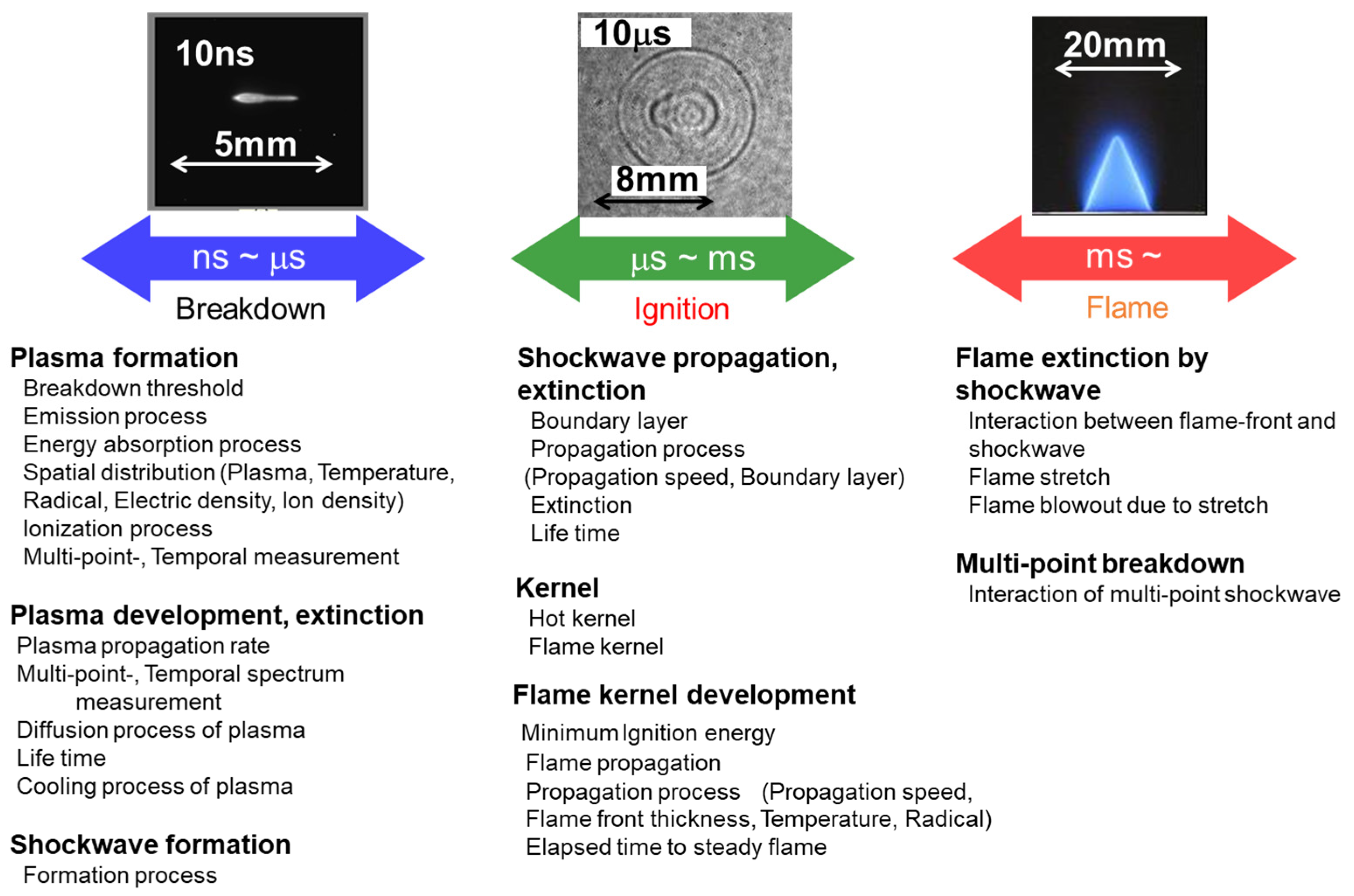



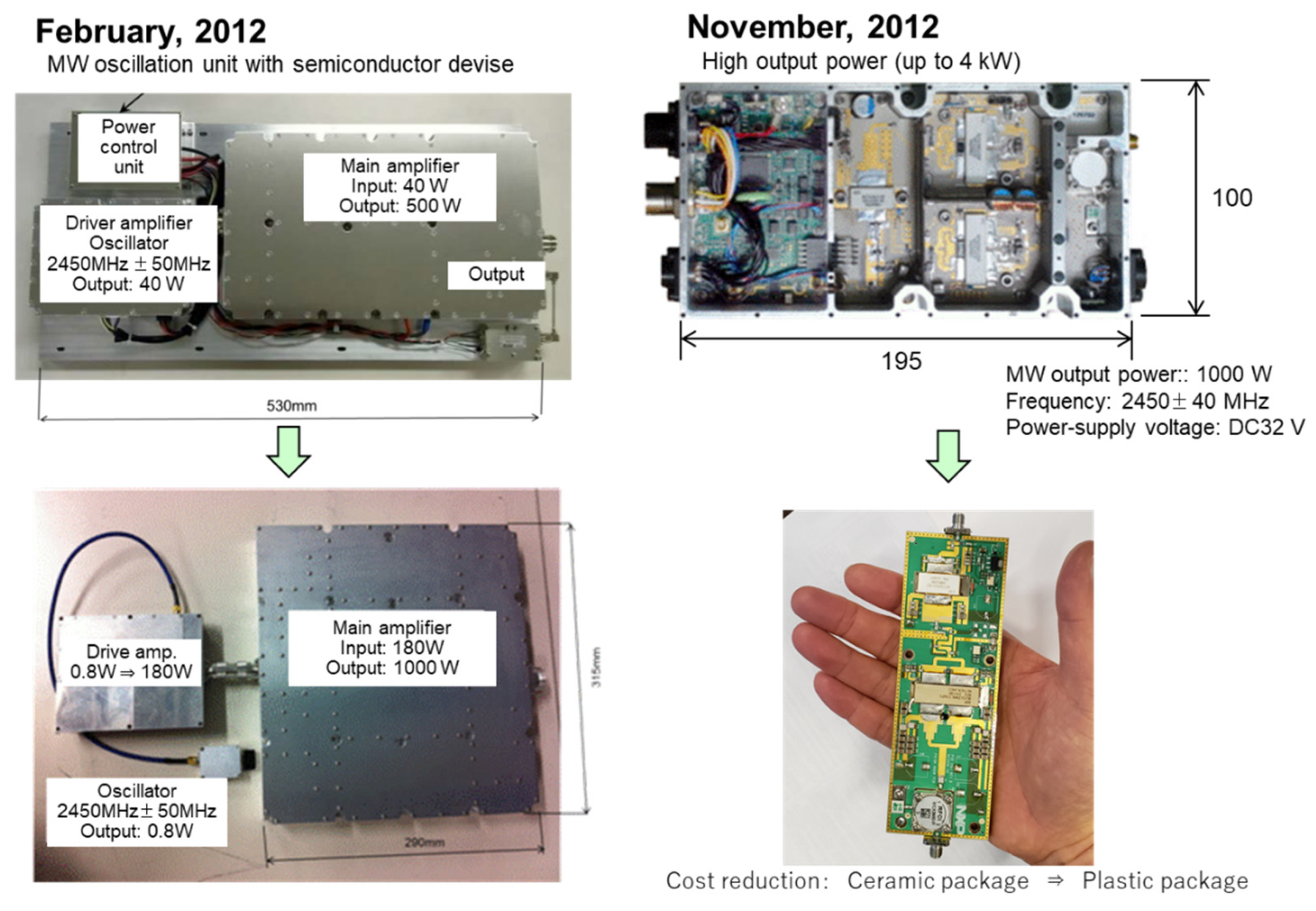

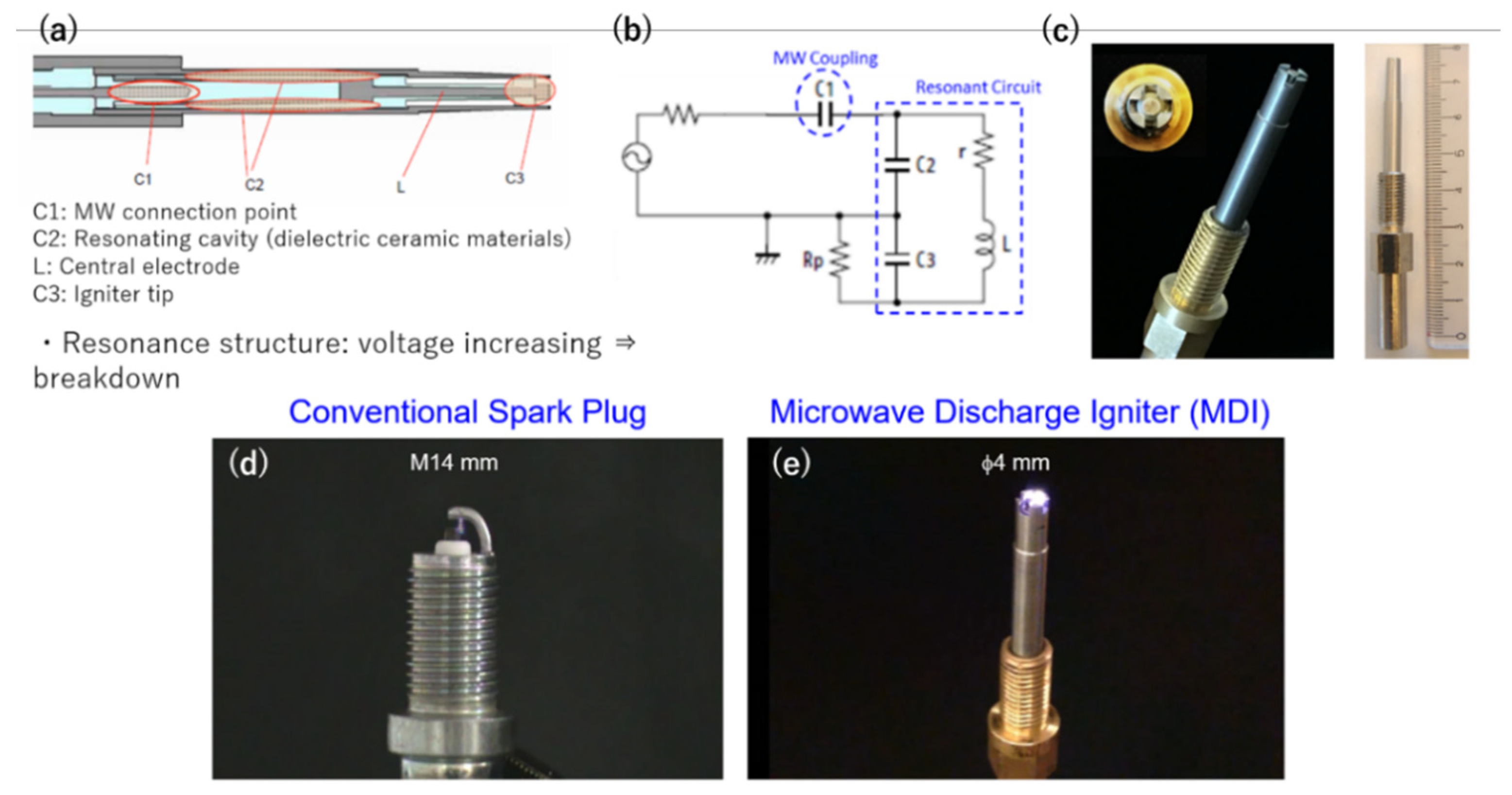
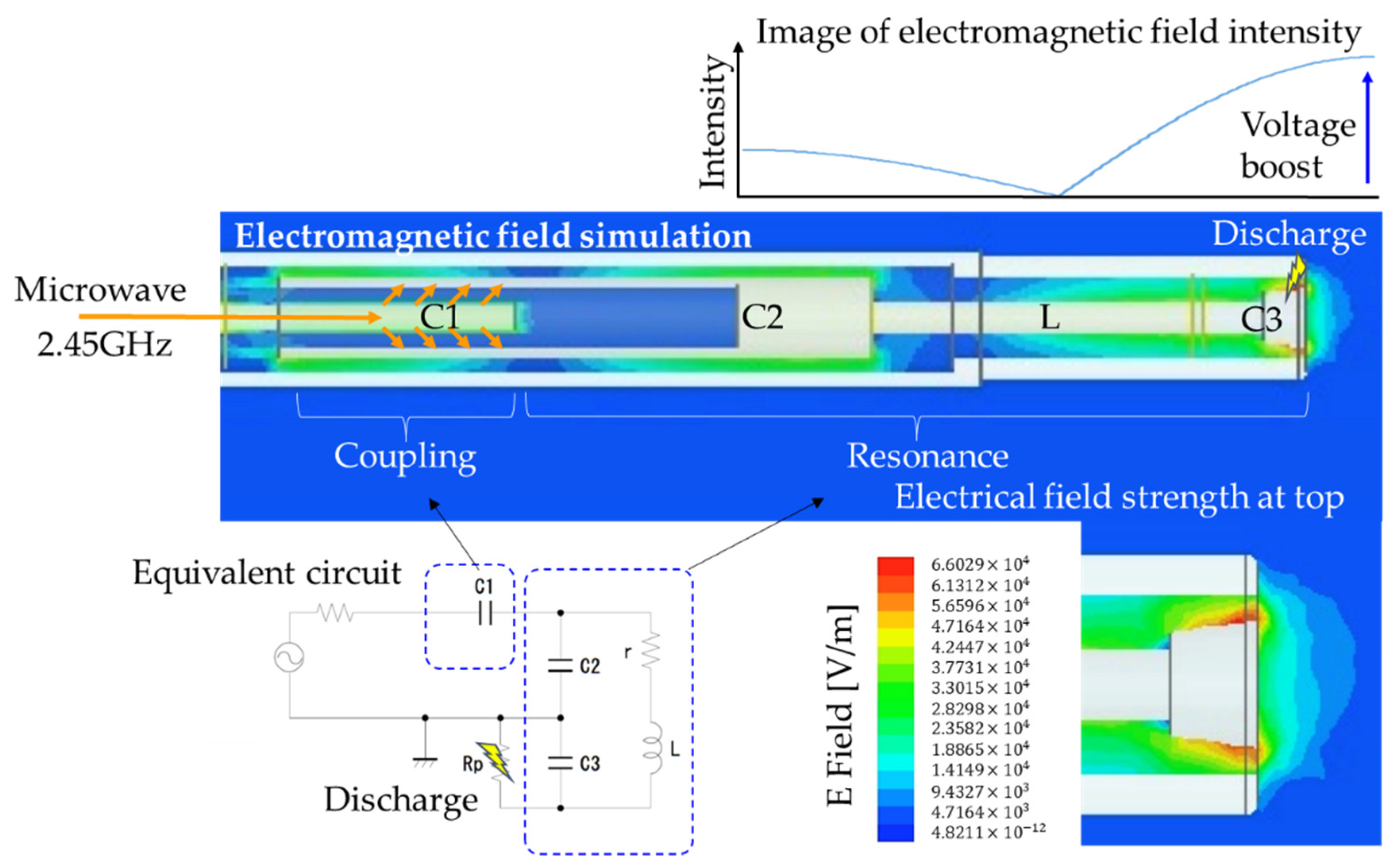
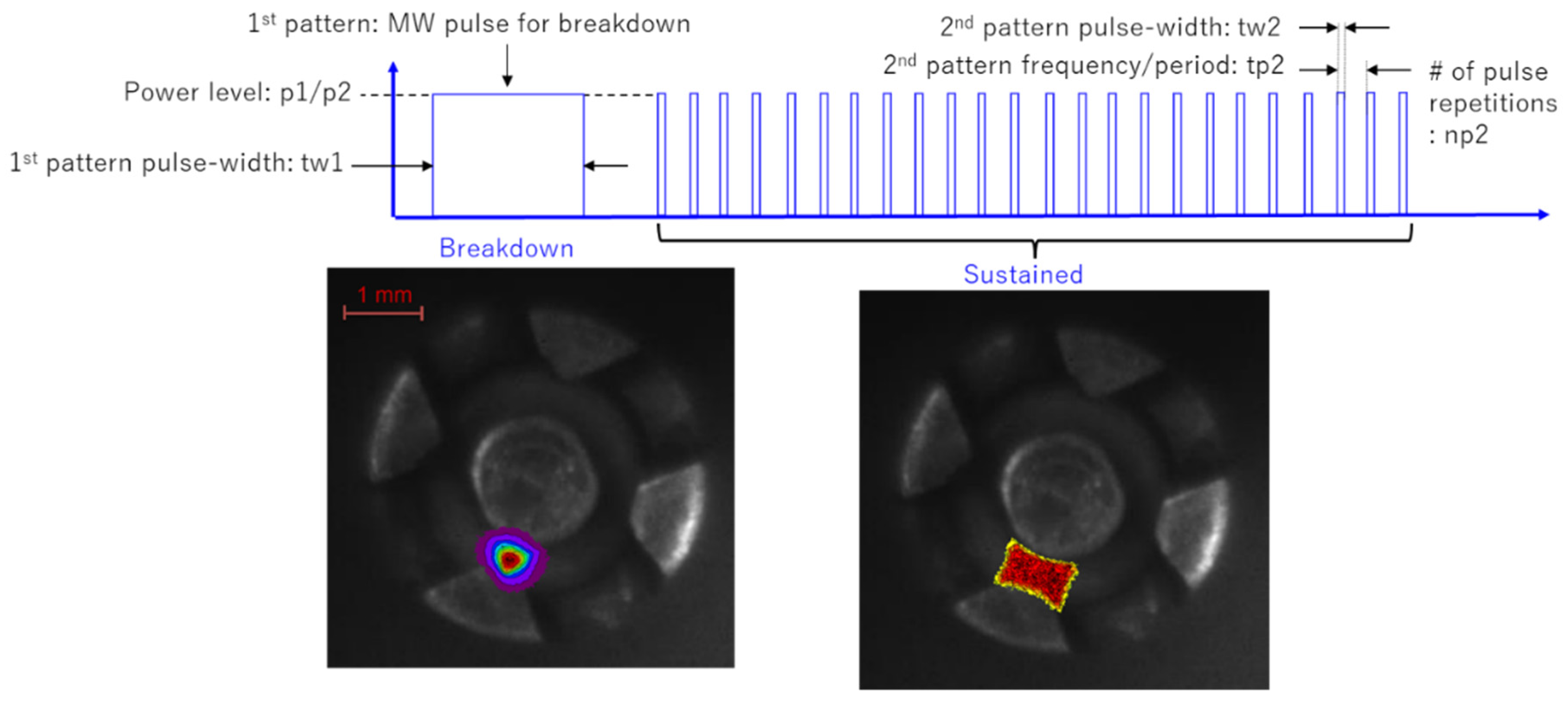
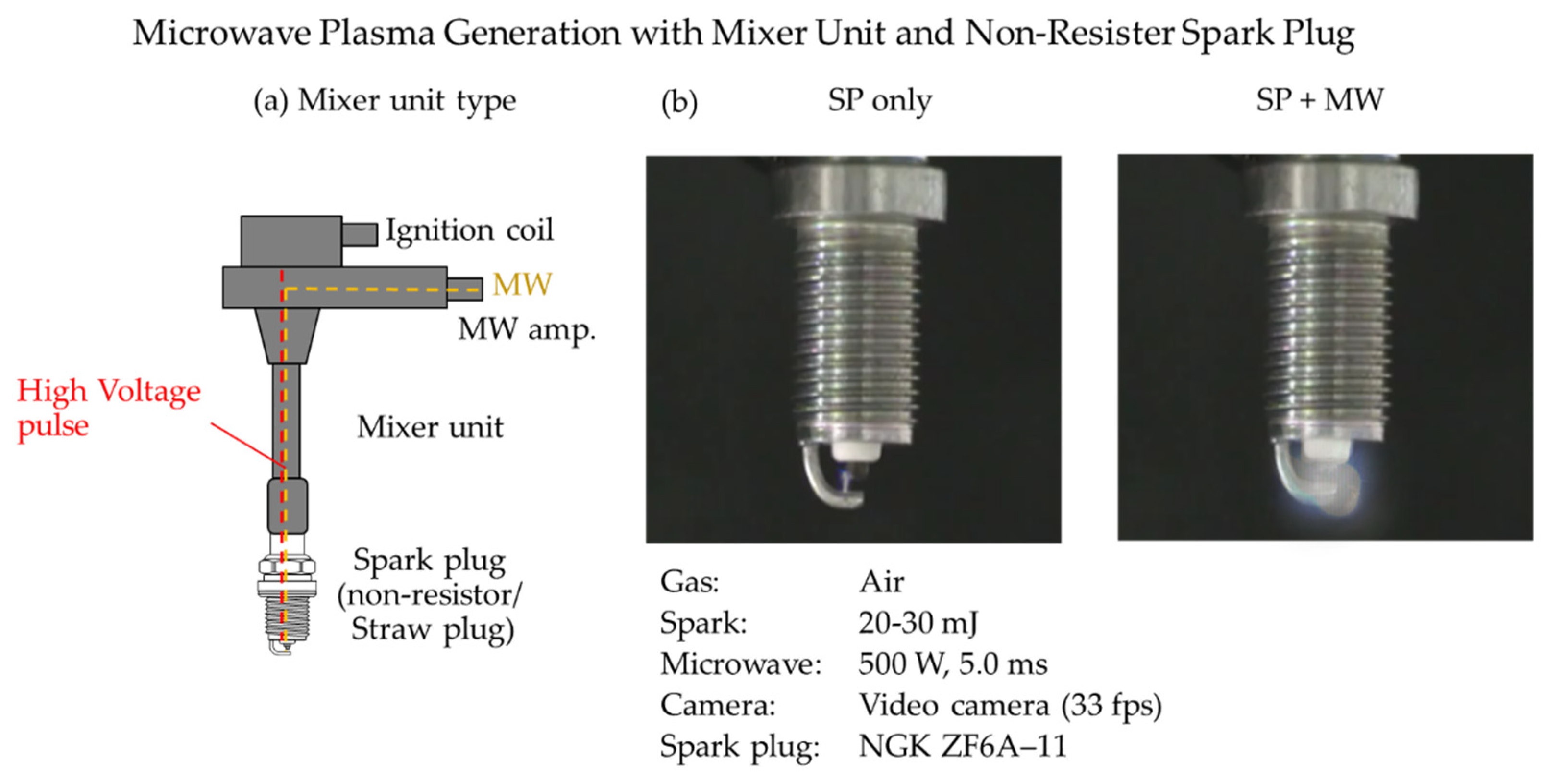
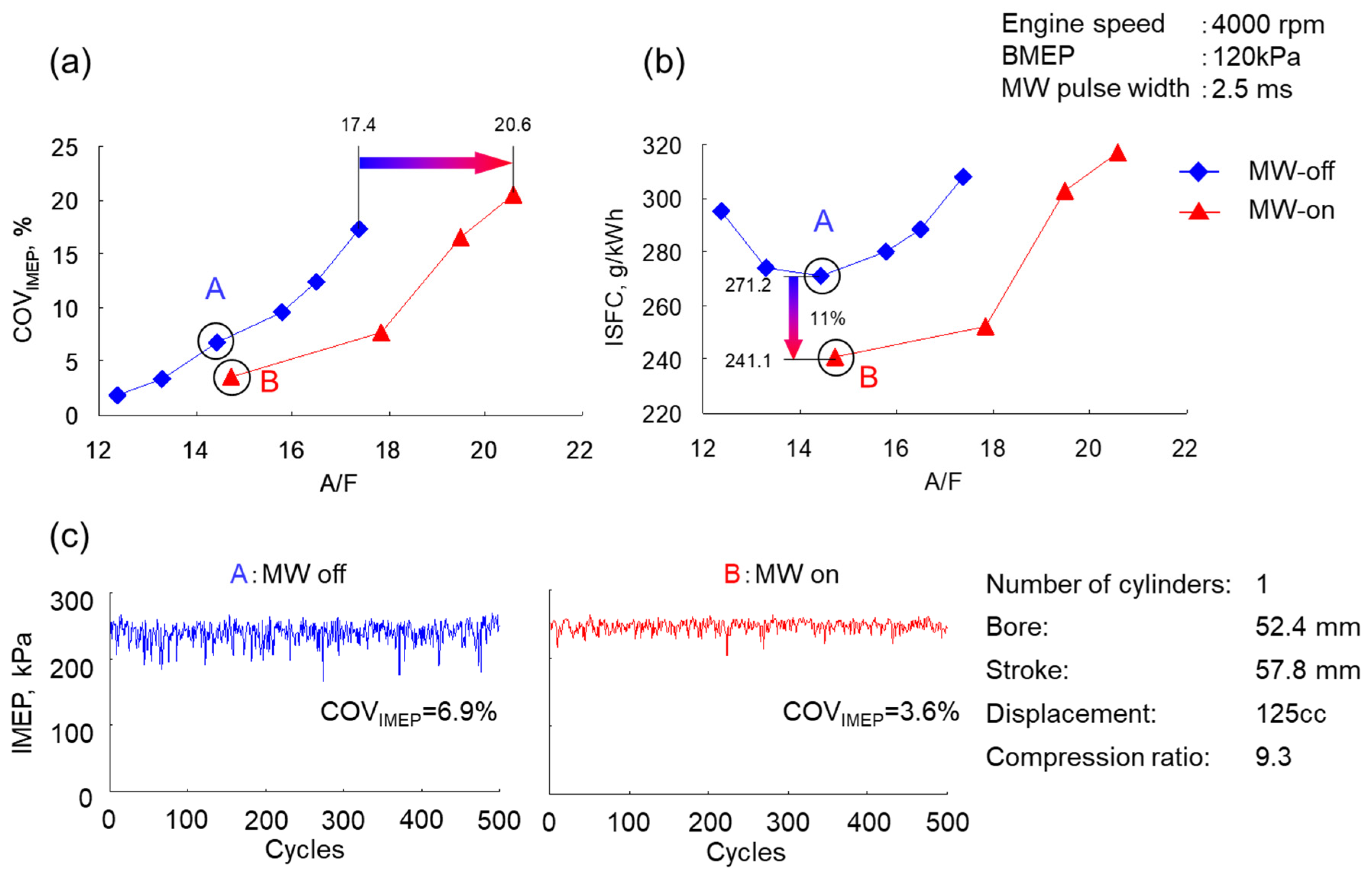

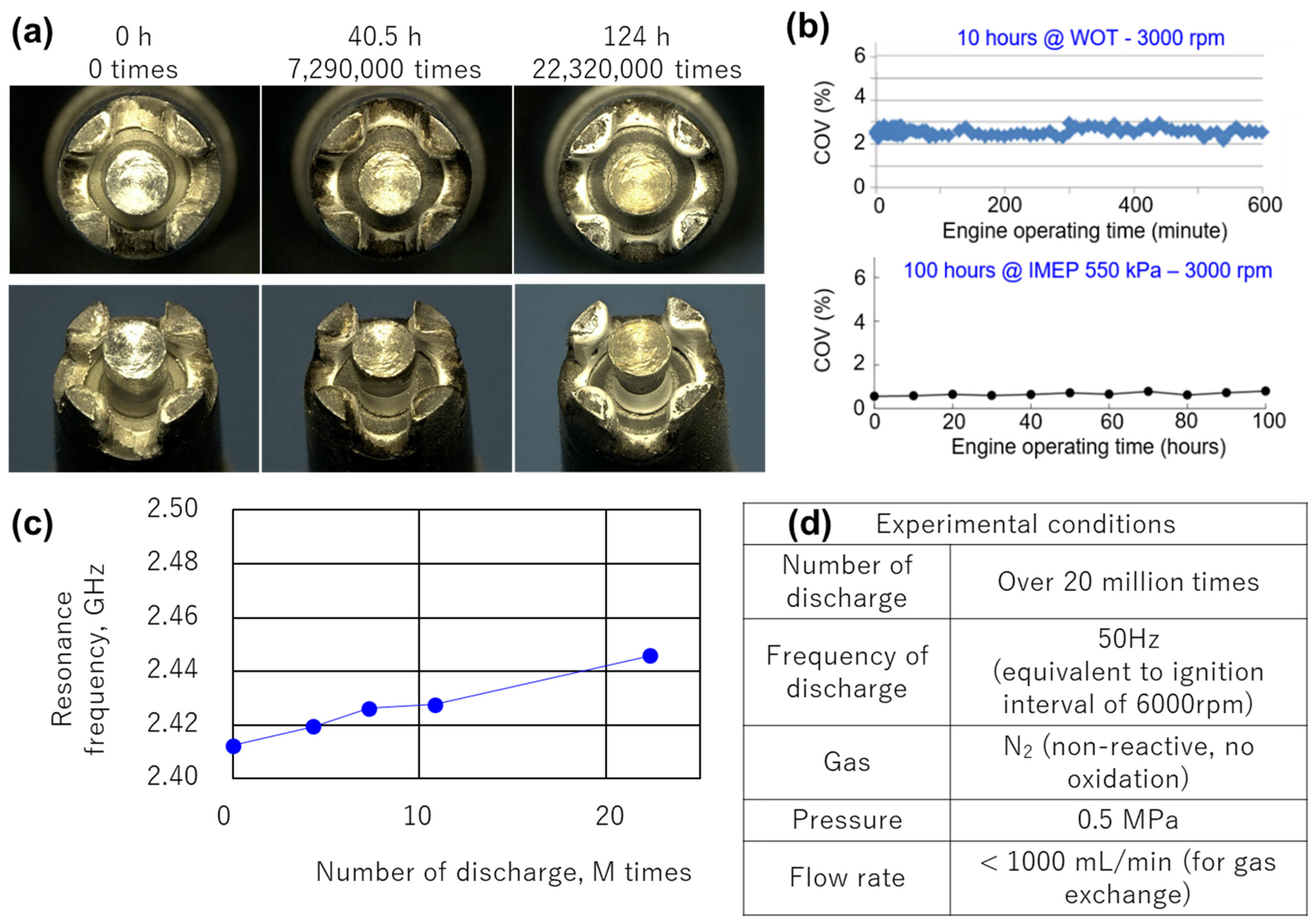


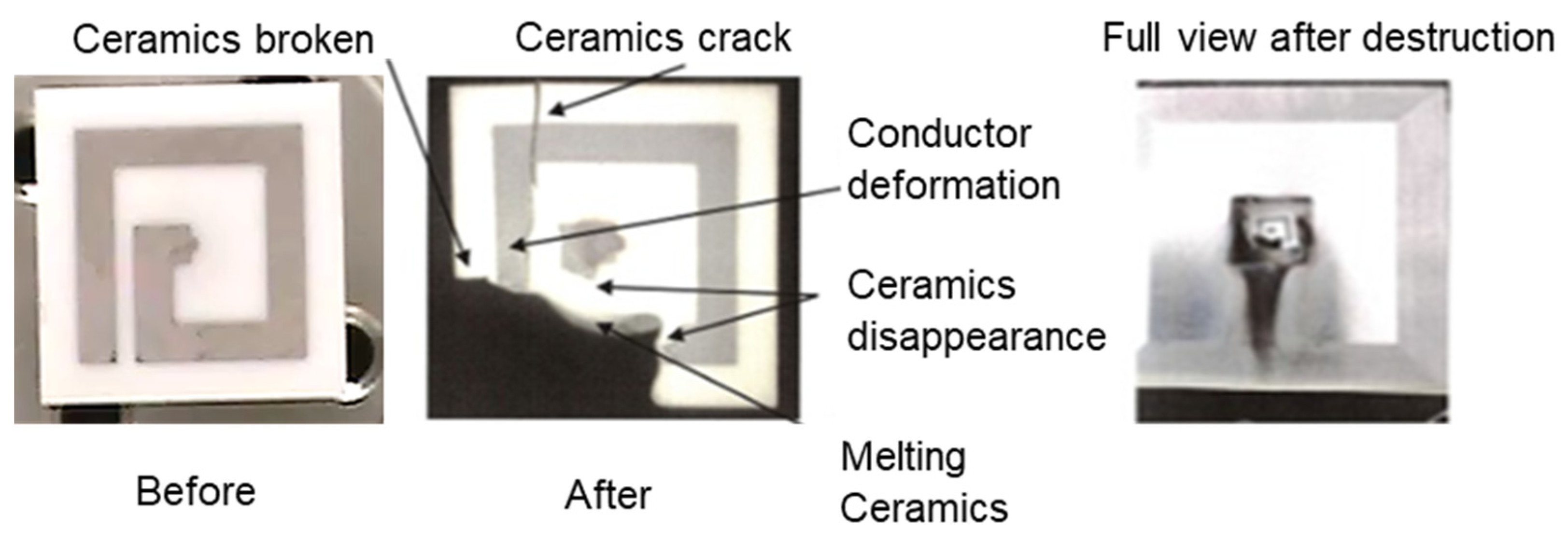
Publisher’s Note: MDPI stays neutral with regard to jurisdictional claims in published maps and institutional affiliations. |
© 2022 by the author. Licensee MDPI, Basel, Switzerland. This article is an open access article distributed under the terms and conditions of the Creative Commons Attribution (CC BY) license (https://creativecommons.org/licenses/by/4.0/).
Share and Cite
Ikeda, Y. Development of 2.45 GHz Semiconductor Microwave System for Combustion Ignition Enhancement and Failure Analysis. Materials 2022, 15, 2042. https://doi.org/10.3390/ma15062042
Ikeda Y. Development of 2.45 GHz Semiconductor Microwave System for Combustion Ignition Enhancement and Failure Analysis. Materials. 2022; 15(6):2042. https://doi.org/10.3390/ma15062042
Chicago/Turabian StyleIkeda, Yuji. 2022. "Development of 2.45 GHz Semiconductor Microwave System for Combustion Ignition Enhancement and Failure Analysis" Materials 15, no. 6: 2042. https://doi.org/10.3390/ma15062042
APA StyleIkeda, Y. (2022). Development of 2.45 GHz Semiconductor Microwave System for Combustion Ignition Enhancement and Failure Analysis. Materials, 15(6), 2042. https://doi.org/10.3390/ma15062042





